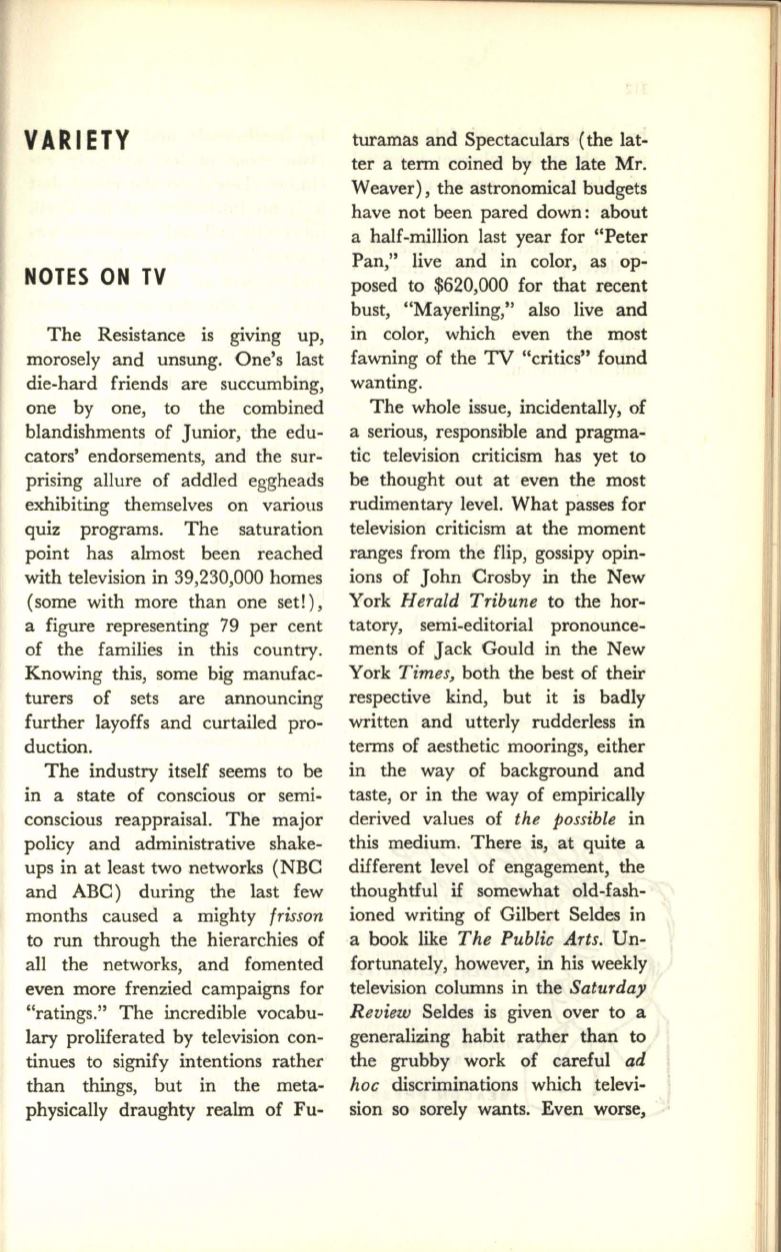
VARIETY
NOTES ON TV
The Resistance is glvmg up,
morosely and unsung. One's last
die-hard friends are succumbing,
one by one, to the combined
blandishments of Junior, the edu–
cators' endorsements, and the sur–
prising allure of addled eggheads
exhibiting themselves on various
quiz programs. The saturation
point has almost been reached
with television in 39,230,000 homes
(some with more than one set! ),
a figure representing 79 per cent
of the families in this country.
Knowing this, some big manufac–
turers of sets are announcing
further layoffs and curtailed pro–
duction.
The industry itself seems to be
in a state of conscious or semi–
conscious reappraisal. The major
policy and administrative shake–
ups in at least two networks (NBC
and ABC) during the last few
months caused a mighty
frisson
to run through the hierarchies of
all the networks, and fomented
even more frenzied campaigns for
"ratings." The incredible vocabu–
lary proliferated by television con–
tinues to signify intentions rather
than things, but in the meta–
physically draughty realm of Fu-
turamas and Spectaculars (the lat–
ter a term coined by the late Mr.
Weaver), the astronomical budgets
have not been pared down: about
a half-million last year for "Peter
Pan," live and in color, as op–
posed to $620,000 for that recent
bust, "Mayerling," also live and
in color, which even the most
fawning of the TV "critics" found
wanting.
The whole issue, incidentally, of
a serious, responsible and pragma–
tic television criticism has yet to
be thought out at even the most
rudimentary level. What passes for
television criticism at the moment
ranges from the flip, gossipy opin–
ions of John Crosby in the New
York
Herald Tribune
to the hor–
tatory, semi-editorial pronounce–
ments of Jack Gould in the New
York
Times,
both the best of their
respective kind, but it is badly
written and utterly rudderless in
terms of aesthetic moorings, either
in the way of background and
taste, or in the way of empirically
derived values of
the possible
in
this medium. There is, at quite a
different level of engagement, the
thoughtful
if
somewhat old-fash–
ioned writing of Gilbert Seldes in
a book like
The Public Arts.
Un–
fortunately, however, in his weekly
television columns in the
Saturday
Review
Seldes is given over to a
generalizing habit rather than to
the grubby work of careful
ad
hoc
discriminations which televi–
sion so sorely wants. Even worse,


